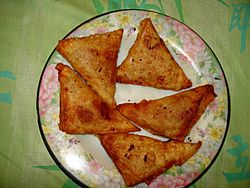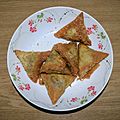Samosa facts for kids

|
|
| Alternative names | Samsa, somsa, sambosak, sambusa, samoosa, singada, samuza |
|---|---|
| Region or state | Indian Subcontinent, Central Asia, Western Asia, Horn of Africa, North Africa, South Africa |
| Main ingredients | Maida or plain flour, potato, onion, spices, green chili, cheese, meat |
A samosa is a very popular snack. It started in Central Asia a long time ago. From there, it traveled to India with traders. Today, samosas are famous in many parts of the world. You can find them in the Indian subcontinent, Southeast Asia, and Central Asia. They are also popular in Western Asia, the Arabian Peninsula, and around the Mediterranean Sea. People enjoy them in the Horn of Africa, North Africa, and South Africa.
Samosas are usually shaped like a triangle. But their shape and size can be different depending on where you are. They can be either baked or fried. The outside crust is made from plain flour. Inside, samosas often have a tasty filling of potatoes and spices. People usually eat them with a spicy sauce called chutney.
In Pakistan, samosas are often eaten as an appetizer. You can easily find them in school canteens and sweet shops. Many families also make samosas at home. Samosas can be made for people who eat only vegetables (vegetarian) or for those who eat meat (non-vegetarian).
Where Did Samosas Come From?
Samosas are thought to have started in Central Asia and Western Asia. The word "samosa" comes from a Persian word, sanbosag.
Different Names for Samosa
Samosas are known by many names around the world. Here are some of them:
| Language | Name |
|---|---|
| Marathi | Samosa |
| Urdu | Sambusak |
| Turkish | samsa böreği |
| Oriya | Shingada |
| Russian | Самса́ [samsa] |
| Bengali | Sing-ra |
| Persian | سمبوسه [Samuza] |
Images for kids
-
Burmese-style samusa are flat and triangular. They are usually smaller than Indian ones.
-
Indonesian-style samosa is known as kue kering.
-
Somali Sambuus being deep-fried.
-
Goan chamuças.
See also
 In Spanish: Samosa para niños
In Spanish: Samosa para niños



















